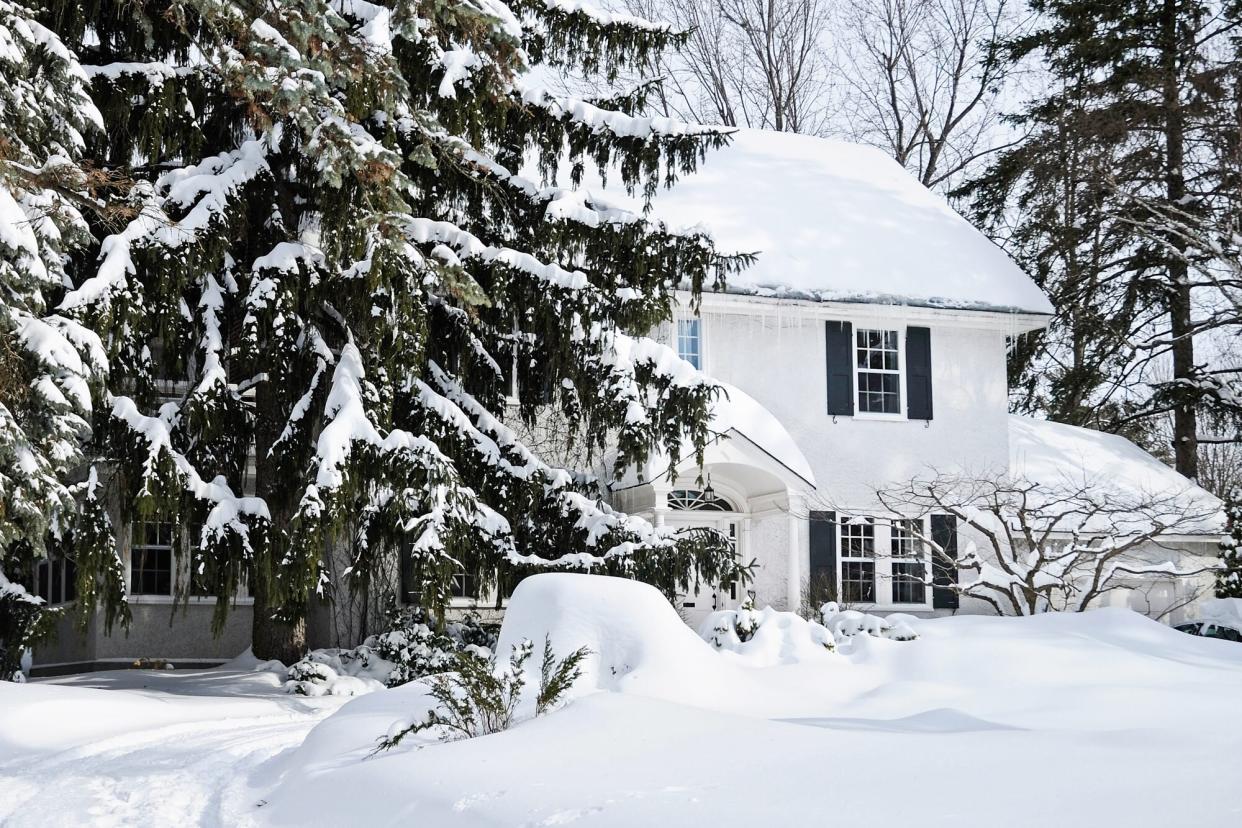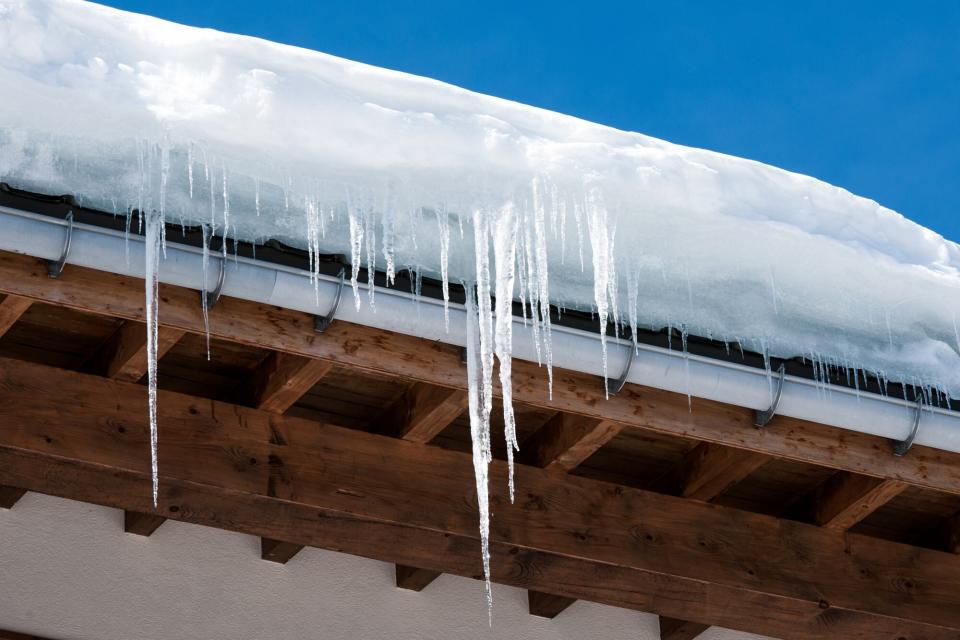This Complete Winter Checklist Will Prepare Your Home for Freezing Temperatures

GETTY IMAGES
As the weather changes, so does your home's needs. This is especially true during winter, when freezing temperatures and winter storms can cause severe damage to your property. To protect your home from frozen pipes, power outages, and other unwanted consequences of cold weather, there are a handful of steps you must take when winterizing your home. Having a checklist on hand when severe weather conditions hit will help you keep your home safe until warmer temperatures return.
Related: The Two Most Common Winter Home Issues—Plus, How to Fix Them

Grace Canaan
1. Prevent Your Pipes From Freezing
Frozen pipes aren't just an inconvenience that blocks from water running into your home, but they can also be costly to repair should they burst. "Temperatures at or below 20 degrees Fahrenheit can cause water in the pipes to freeze," says Gary McCoy, store manager at Lowe's. "When that happens, the water—now ice—in your pipes expands and exerts pressure on the pipe. Too much pressure can lead to a ruptured pipe." Pipes that run along exterior walls or have little to no insulation are most susceptible to freezing—as are supply pipes in unheated interior areas.
Add Insulation
Covering your pipes with insulation is a long-term way to prevent frozen pipes and keep your home warm when cold weather hits. "You can use pipe wrap insulation—it winds around the pipe—or tubular pipe insulation," says McCoy. "Another option is to install pipe heat cables that are thermostat controlled,. Just be aware that you may have to unplug and plug in the cables at the end of this winter and beginning of the next."
Protect Exterior Faucets
Preventing frozen pipes has outdoor component, too, as sprinkler systems, swimming pool lines, and hoses are all susceptible to freezing. "For any outdoor faucets with cut-off valves, be sure they are closed and faucets are drained," says Joe Cobb, customer training manager at The Home Depot. Additionally, you can cover exterior faucets with insulated covers to help retain warmth from the home's interior. Keep garden hoses disconnected from exterior faucets to prevent water from freezing inside the hose (which could actually rupture those outside faucets).
Keep Water Running
Let cold water drip from indoor faucets located near walls without proper insulation. "If cold weather settles in and you notice temperatures beginning to drop, start a small drip of both hot water and cold water in the kitchen, bath, laundry areas and any other faucets in the home," says Cobb. "A small water drip is all that is needed to keep water moving through the system and prevent frozen pipes."

GETTY IMAGES
2. Clean Your Gutters
Cleaning your gutters is an essential part of preparing for winter. If water gets trapped in your gutters during cold temperatures, it can freeze and force ice back under the edge of your home's shingles, causing long term damage and making your roof susceptible to leaks. "To prevent clogging, inspect and clean the gutters of leaves and other debris," says McCoy. "For a shortcut, you could consider purchasing gutter guards. They will help keep out leaves, pine needles, roof sand grit, and other debris from your gutter, and only need to be occasionally brushed off."
3. Seal Holes and Cracks
Keep the cold out of your home by checking for any cracks and holes in your foundation. Use caulk around windows and foam outlet protectors as a preventative measure. Additionally, implementing rubber or vinyl weather stripping around doors and windows can help insulate areas where cracks let cold air in—or heat is released out. "Replace your door seals, door sweeps, or thresholds to keep cold outside air from seeping into your home," says Cobb.
4. Check Your Thermostat
If your thermostat gives out on you during winter, you won't have a working heat source to keep the inside of your home warm. It's possible all your thermostat needs is new batteries, so be sure to have some on hand before severe weather hits. If the entire thermostat stops working and you need a replacement, electric heaters are the safest short-term heating solution. "They can be used to effectively heat smaller spaces and should be kept away from any flammable materials," says McCoy.
Related: This Is the Optimal Temperature for Your Home in Summer and Winter
5. Get a Generator
To prepare for potential power outages, consider getting a generator for your home. "A home generator will have you up and running within seconds of losing power and can be used to run electrical heat sources during power outages, such as a water heater," says Cobb. "Always run generators outside at least 15 to 20 feet away from a doorway with the exhaust facing away from the home."

GETTY IMAGES
6. Check Your Fireplace
Before depending on your fireplace as a source of warmth, make sure you give it a thorough inspection to ensure it'll run properly. Look for any abnormalities like cracks, holes, and other forms of damage prior to using your fireplace during severe weather. "If not properly maintained, a faulty fireplace can lead to a house fire, or a potential carbon monoxide build up in the home," says McCoy. Consider hiring a professional to come inspect your fireplace for nests, creosote buildup, soot, and other debris prior to firing it up. "Lastly, it's important to also vacuum or sweep out any accumulated ash from the firebox," says McCoy.
7. Make an Emergency Kit
Preparedness is key when it comes to severe winter weather. "The Red Cross encourages every household to have an emergency preparedness kit with essentials for evacuations, loss of power, or if you are stuck in your home for an extended period of time," says Stephanie Fox of American Red Cross National Headquarters. "These kits should include non-perishable food items, water, extra prescription medication, a first aid kit, copies of important documents, flashlights and lanterns with extra batteries, extra sets of warm clothing, and specific items to accommodate pets, children, the elderly, or any family members who may have a disability."
7. Protect Your Outside Equipment
Just as you want to keep everything inside your home safe, you also want to protect your outdoor items, as well. "You'll need to bring plants and flowering trees inside before the first cold snap," says McCoy. "You should also consider storing your outdoor furniture and grills in the basement or garage, as cold temperatures, snow, and ice can cause them damage." If your house doesn't have enough storage space for this, consider purchases covers for your grill and patio furniture.

